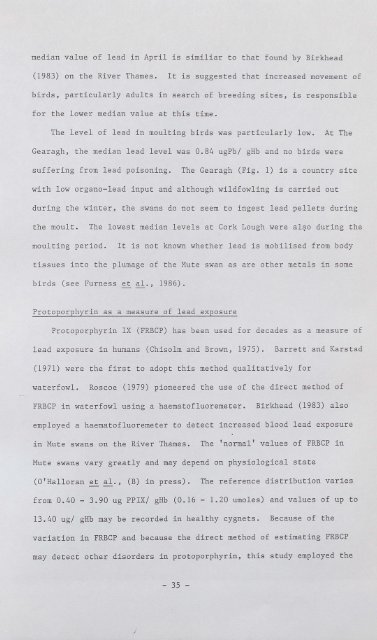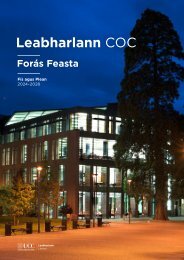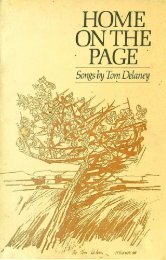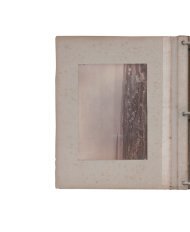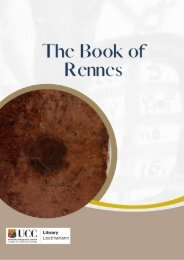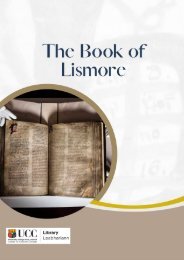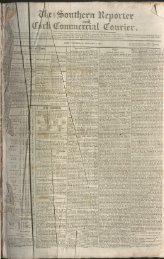Lead Toxicity in Mute Swans
LEAD TOXICITY IN MUTE SWANS Cygnus olor (Gmelin). By JOHN O'HALLORAN A thesis submitted to the National University of Ireland in candidature for the degree of Doctor of Philosophy September 1987
LEAD TOXICITY IN MUTE SWANS
Cygnus olor (Gmelin).
By
JOHN O'HALLORAN
A thesis submitted to the National University of Ireland
in candidature for the degree of Doctor of Philosophy
September 1987
You also want an ePaper? Increase the reach of your titles
YUMPU automatically turns print PDFs into web optimized ePapers that Google loves.
median value of lead <strong>in</strong> April is similiar to that found by Birkhead<br />
(1983) on the River Thames. It is suggested that <strong>in</strong>creased movement of<br />
birds, particularly adults <strong>in</strong> search of breed<strong>in</strong>g sites, is responsible<br />
for the lower median value at this time.<br />
The level of lead <strong>in</strong> moult<strong>in</strong>g birds was particularly low.<br />
At The<br />
Gearagh, the median lead level was 0.84 ugPb/ gHb and no birds were<br />
suffer<strong>in</strong>g from lead poison<strong>in</strong>g.<br />
The Gearagh (Fig. 1) is a country site<br />
with low organo-lead <strong>in</strong>put and although wildfowl<strong>in</strong>g is carried out<br />
dur<strong>in</strong>g the w<strong>in</strong>ter, the swans do not seem to <strong>in</strong>gest lead pellets dur<strong>in</strong>g<br />
the moult. · The lowest median levels at Cork Lough were al90 dur<strong>in</strong>g the<br />
moult<strong>in</strong>g period.<br />
It is not known whether lead is mobilised from body<br />
tissues <strong>in</strong>to the plumage of the <strong>Mute</strong> swan as are other metals <strong>in</strong> some<br />
birds (see Furness et al., 1986).<br />
Protoporphyr<strong>in</strong> as a measure of lead exposure<br />
Protoporphyr<strong>in</strong> IX (FRBCP) has been used for decades as a measure of<br />
lead exposure <strong>in</strong> humans (Chisolm and Brown, 1975).<br />
Barrett and Karstad<br />
(1971) were the first to adopt this method qualitatively for<br />
waterfowl.<br />
Roscoe (1979) pioneered the use of the direct method of<br />
FRBCP <strong>in</strong> waterfowl us<strong>in</strong>g a haematofluoremeter.<br />
Birkhead (1983) also<br />
employed a haematofluoremeter to detect <strong>in</strong>creased blood lead exposure<br />
<strong>in</strong> <strong>Mute</strong> swans on the River Thames.<br />
The 'normal' values of FRBCP <strong>in</strong><br />
<strong>Mute</strong> swans vary greatly and may depend on physiological state<br />
(O'Halloran et al., (B) <strong>in</strong> press).<br />
The reference distribution varies<br />
from 0.40 - 3.90 ug PPIX/ gHb (0.16 - 1.20 umoles) and values of up to<br />
13.40 ug/ gHb may be recorded <strong>in</strong> healthy cygnets. Because of the<br />
variation <strong>in</strong> FRBCP and because the direct method of estimat<strong>in</strong>g FRBCP<br />
may detect other disorders <strong>in</strong> protoporphyr<strong>in</strong>, this study employed the<br />
- 35 -


